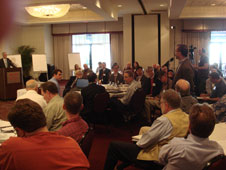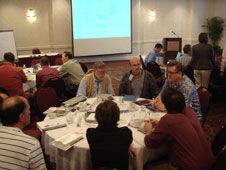May 28, 2010 Vol. 3, Issue 5
Principal investigators, project managers, and project scientists gathered to exchange stories and knowledge at the second Principal Investigator Forum in Annapolis, Maryland.
The Academy’s second Principal Investigator Team Masters Forum, hosted in partnership with the Science Mission Directorate, brought together teams from the New Frontiers Mission-3 and the Mars Scout-2 Mission, as well as others selected for a future Mission of Opportunity, to gain a better understanding of the role of a Principal Investigator (PI) at NASA. Master practitioners from past science missions shared stories, perspectives, lessons learned, and best practices with their colleagues.
“Unsuccessful missions are led by Napoleons,” said Ed Weiler, Associate Administrator of NASA’s Science Mission Directorate (SMD). “Successful missions are led by teams.” He noted that small missions can accomplish valuable science in shorter timeframes than flagship missions like the James Webb Space Telescope, and he called for a balance between the two. “SMD is supposed to do the best science, not just do more science.”
John Mather, who won a Nobel Prize in physics for the research he did as PI for the Far Infrared Absolute Spectrophotometer (FIRAS) on the Cosmic Background Explorer (COBE), shared four main insights from that project:
- No one person can be as essential as he or she thinks.
- If you have not tested it, it will not work.
- As a PI, you are basically a systems engineer, so study the discipline.
- It takes a wide range of personalities to make a team.
Mather also addressed the risk of being good. “If you’re the PI, people think you’re right,” he said. “You are a single-point failure walking on Earth.” He suggested having an outside expert double-check the PI’s work. He also acknowledged that not everything can be tested as it will perform in space, but added, “If something matters to you, then you’d better measure it at least two different ways. If they don’t agree, you’ve got to resolve the discrepancy. You don’t have to have an end-to-end test, but if you don’t, you had better have two ways to make sure of something.”

Orlando Figueroa (right), deputy center director for Goddard Space Flight Center, asks Dennis McCarthy (left), project manager on COBE, a question during his session on the first day of the Forum. Credit: NASA APPEL
COBE deputy project manager Dennis McCarthy noted that he used to carry around a piece of paper in his wallet with two letters written on it: BP. It stood for “be professional, proved, practical, be protective of the people and the hardware, and to persevere,” he said. While acknowledging that the work on COBE was hard, “I don’t think anyone left [the project],” he said. “The passion that these people had and the fact that somebody would tell me this was Nobel-type science. No one left.” Both Mather and McCarthy believe that COBE could be done again within NASA’s current procedural requirements, such as NPR 7120.5D. Project managers just have to work with or around it as need be, according to McCarthy.
McCarthy also served as project manager on the Far Ultraviolet Spectroscopic Explorer (FUSE). FUSE, a twenty-foot-tall, 3,000-pound spectrograph, bounced back from cancellation when McCarthy and PI Warren Moos converted it into a PI-led mission with a greatly scaled-back budget. From McCarthy’s perspective, FUSE was successful largely due to the systems engineering that took place over the project lifecycle.
Orlando Figueroa, deputy center director for Goddard Space Flight Center, reinforced McCarthy’s point about systems engineering. “I think it is important to practice how systems engineering is applied,” he said. “In the end we are all engineers of systems.”
Steve Jolly of Lockheed Martin engaged participants in a discussion about systems engineering and the increasing complexity of software for space missions. In the world of software, said Jolly, “there are a thousand ways to failmost have not been explored.” There needs to be a shift in systems engineering, with an emphasis on recruiting people with software and engineering backgrounds, he suggested.
Many PI missions have to find ways to work inside the box. Dennis Matson, project scientist for Cassini, shared his story about employing a free-market system to manage project reserves. In order to deliver all of the eighteen instruments on time and within cost and mass limitations, the global project teams could exchange mass, power, and cost with others on the project. The “Casino Mission,” as the teams dubbed it, established rules that reinforced transparency and a strong sense of teamwork, resulting in all 18 instruments flying to Saturn.

PI-mission team members working through a knowledge capture activity at the end of the day. Credit: NASA APPEL
Sean Solomon, PI, Peter Bedini, project manager, and Eric Finnegan, systems engineer, presented their lessons learned on the Mercury Surface, Space Environment, Geochemistry, and Ranging (MESSENGER) mission, which is scheduled to arrive at Mercury on March 18, 2011. MESSENGER had both anticipated and unanticipated challenges, explained Solomon. The team knew its spacecraft would have to withstand the intensity of the sun at close range, but it did not expect management turnover or a sudden loss of expertise due to vendor changes.
PIs don’t know everything, cautioned Andrew Cheng, project scientist on the Near Earth Asteroid Rendezvous (NEAR) mission. He told participants that, “the decisions you have to make are going to be about topics that not only do you not know very much [about], you may not know anything about. But you have to make the decisions…because most problems, particularly in our business, do not get better with age.”
On the final day of the forum, Chris Scolese, NASA Associate Administrator, took questions from participants. He spent a significant amount of time discussing the review process for flight projects and the NPR 7120.5 procedural requirements for space flight projects. “7120 doesn’t have very many requirements,” he said. “First, 7120 asks for a set of independent reviews, which help everyone understand what’s going on in the project. Second, there must be a structure to the project, and third, everything must be documented. Fourth, anyone can disagree and voice their dissenting opinion. That’s really what 7120 says.”
Lessons are learned if they are shared, said Noel Hinners, former director of Goddard Space Flight Center, citing a primary reason for convening the forum. It is important to know and understand one another, he said. “Mission success is ultimately a function of superb leadership.”





